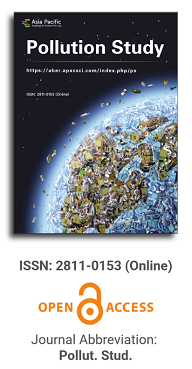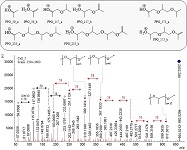
Asia Pacific Academy of Science Pte. Ltd. (APACSCI) specializes in international journal publishing. APACSCI adopts the open access publishing model and provides an important communication bridge for academic groups whose interest fields include engineering, technology, medicine, computer, mathematics, agriculture and forestry, and environment.

The (partial) replacement of synthetic polymers with bioplastics is due to increased production of conventional packaging plastics causing for severe environmental pollution with plastics waste. The bioplastics, however, represent complex mixtures of known and unknown (bio)polymers, fillers, plasticizers, stabilizers, flame retardant, pigments, antioxidants, hydrophobic polymers such as poly(lactic acid), polyethylene, polyesters, glycol, or poly(butylene succinate), and little is known of their chemical safety for both the environment and the human health. Polymerization reactions of bioplastics can produce no intentionally added chemicals to the bulk material, which could be toxic, as well. When polymers are used to food packing, then the latter chemicals could also migrate from the polymer to food. This fact compromises the safety for consumers, as well. The scarce data on chemical safety of bioplastics makes a gap in knowledge of their toxicity to humans and environment. Thus, development of exact analytical protocols for determining chemicals of bioplastics in environmental and food samples as well as packing polymers can only provide warrant for reliable conclusive evidence of their safety for both the human health and the environment. The task is compulsory according to legislation Directives valid to environmental protection, food control, and assessment of the risk to human health. The quantitative and structural determination of analytes is primary research task of analysis of polymers. The methods of mass spectrometry are fruitfully used for these purposes. Methodological development of exact analytical mass spectrometric tools for reliable structural analysis of bioplastics only guarantees their safety, efficacy, and quality to both humans and environment. This study, first, highlights innovative stochastic dynamics equations processing exactly mass spectrometric measurands and, thus, producing exact analyte quantification and 3D molecular and electronic structural analyses. There are determined synthetic polymers such as poly(ethylenglycol), poly(propylene glycol), and polyisoprene as well as biopolymers in bags for foodstuffs made from renewable cellulose and starch, and containing, in total within the 20,416–17,495 chemicals per sample of the composite biopolymers. Advantages of complementary employment in mass spectrometric methods and Fourier transform infrared spectroscopy is highlighted. The study utilizes ultra-high resolution electrospray ionization mass spectrometric and Fourier transform infrared spectroscopic data on biodegradable plastics bags for foodstuffs; high accuracy quantum chemical static methods, molecular dynamics; and chemometrics. There is achieved method performance |r| = 0.99981 determining poly(propylene glycol) in bag for foodstuff containing 20,416 species and using stochastic dynamics mass spectrometric formulas. The results highlight their great capability and applicability to the analytical science as well as relevance to both the fundamental research and to the industry.
Assessment of sustainable development models for rural watershed areas with a focus on environmental components
Vol 5, Issue 2, 2024
Download PDF
Abstract
From the point of view of the systemic approach in sustainable rural development programs, all components should be considered concerning each other, but one of the most important components is the environmental index in development programs. Considering that the lack of attention to the environmental components in the development plans of many projects has failed and many challenges have been created in the environmental components. The current research aims to evaluate the role of environmental components in the sustainable development of rural areas. For this purpose, a questionnaire was compiled and using Cochran’s formula, a sample size of 100 copies of the questionnaire was completed from household heads, and in addition, 20 copies of the questionnaire were completed to survey the relevant officials. SPSS software was used to classify and analyze data and information, and the AHP model was used to examine the relationship between variables and prioritize them. The studied area was located in the north of Tehran-Mashhad asphalt road and about 50 km east of Garmsar city. The results of the study indicate that there is a significant relationship between the environmental components and the sustainable development of the rural areas of the studied area, which requires the special attention of the officials in this sector. It has the most importance in this region. At the end, suggestions for better planning and sustainable development are given.
Keywords
References
- Ghorbani M, Ghaderi N, Estelaji F, et al. Evaluating Surface Water Collection Infrastructure for Management of Urban Flood Risk: Integrating HEC-RAS with GIS in Overland Flow Modeling and Flood Hazard Zone Mapping within the Kan River Watershed of Tehran. AGU24; 2024.
- Meadowcroft J. Sustainable Development: A New(Ish) Idea for a New Century? Political Studies. 2000; 48(2): 370-387. doi: 10.1111/1467-9248.00265
- Estelaji F, Zahedi R, Gitifar A, et al. Integrating HEC-RAS, GIS, and LISREL for assessing and enhancing urban building resilience against flood threats: Comprehensive model and analysis. Heliyon. 2024; 10(20): e39463. doi: 10.1016/j.heliyon.2024.e39463
- Sen A. A survey of sustainable development: social and economic dimensions. Island Press; 2013.
- Nisa A, Surtikanti HK. Environmental ethics of Kuta traditional village community in preserving the environment and its future prospects. Interaction, Community Engagement, and Social Environment. 2024; 1(2). doi: 10.61511/icese.v1i2.2024.388
- Estelaji F, et al. Efficiency Evaluation of Surface Water Collection Infrastructure during Floods: Information Analysis and Zoning Management. Journal of Information Analysis. 2024.
- Zahedi R, Yousefi H, Aslani A, et al. Water, energy, food and environment nexus (WEFEN): Sustainable transition, gaps and Covering approaches. Energy Strategy Reviews. 2024; 54: 101496. doi: 10.1016/j.esr.2024.101496
- Shamaee SH, Yousefi H, Zahedi R. Assessing urban development indicators for environmental sustainability. Discover Sustainability. 2024; 5(1). doi: 10.1007/s43621-024-00563-1
- Noorollahi Y, Zahedi R, Ahmadi E, et al. Low carbon solar-based sustainable energy system planning for residential buildings. Renewable and Sustainable Energy Reviews. 2025; 207: 114942. doi: 10.1016/j.rser.2024.114942
- Beatley T, Manning K. The ecology of place: Planning for environment, economy, and community. Island Press; 2013.
- Moghadam SS, Gholamian MR, Zahedi R, et al. Designing a multi-purpose network of sustainable and closed-loop renewable energy supply chain, considering reliability and circular economy. Applied Energy. 2024; 369: 123539. doi: 10.1016/j.apenergy.2024.123539
- Zahedi R, Yousefi H, Aslani A, et al. Sustainable dynamic planning and policy implementation for water, energy and food resources. Energy Strategy Reviews. 2024; 54: 101455. doi: 10.1016/j.esr.2024.101455
- Zahedi R, Yousefi H, Aslani A, et al. Water, energy and environment nexus: Quantitative assessment for integrated power plants with renewable energy. Energy Strategy Reviews. 2024; 53: 101410. doi: 10.1016/j.esr.2024.101410
- Estelaji F, Moniri N. Earthquake, flood and resilience management through spatial planning, decision and information system. Future Technology. 2024; 3(2): 11-21. doi: 10.55670/fpll.futech.3.2.2
- Hajer MA. The politics of environmental discourse: Ecological modernization and the policy process. Clarendon Press; 1995.
- Holden E, Linnerud K, Banister D. Sustainable development: Our Common Future revisited. Global Environmental Change. 2014; 26: 130-139. doi: 10.1016/j.gloenvcha.2014.04.006
- Hoff M. Sustainable community development: Studies in economic, environmental, and cultural revitalization. CRC Press; 1998.
- Zahedi R, Ahmadi A, Gitifar S. Feasibility study of biodiesel production from oilseeds in Tehran province. Journal of Renewable and New Energy. 2023; 10(1): 86-96. doi: 10.52547/jrenew.10.1.86
- Naseri A, Estelaji F, Samani A, et al. Simulating the performance of HOV lanes for optimal urban traffic management. Transportation Research Interdisciplinary Perspectives. 2024; 23: 101010. doi: 10.1016/j.trip.2023.101010
- Mahmoudi N, Sepandi M, Golaki M, et al. Environmental sustainability in hospitals: Dual analysis of electrical consumption and pollutant emissions. Cleaner Engineering and Technology. 2024; 19: 100740. doi: 10.1016/j.clet.2024.100740
- Zahedi R, Sadeghitabar E, Khazaee M, et al. Potentiometry of wind, solar and geothermal energy resources and their future perspectives in Iran. Environment, Development and Sustainability. 2024.
- Yousefi H, Moradi S, Zahedi R, et al. Developed analytic hierarchy process and multi criteria decision support system for wind farm site selection using GIS: A regional-scale application with environmental responsibility. Energy Conversion and Management: X. 2024; 22: 100594. doi: 10.1016/j.ecmx.2024.100594
- Rieniets T. Shrinking Cities: Causes and Effects of Urban Population Losses in the Twentieth Century. Nature and Culture. 2009; 4(3): 231-254. doi: 10.3167/nc.2009.040302
- Chen M, Shen R. Rural Settlement Development in Western China: Risk, Vulnerability, and Resilience. Sustainability. 2023; 15(2): 1254. doi: 10.3390/su15021254
- Kaygusuz K. Energy services and energy poverty for sustainable rural development. Renewable and Sustainable Energy Reviews. 2011; 15(2): 936-947. doi: 10.1016/j.rser.2010.11.003
- Mont O. Consumption and ecological economics: Towards sustainability. Ecological economics research trends, Nova Science Publishers, New York; 2007.
- Balint PJ, Stewart RE, Desai A, et al. Wicked Environmental Problems. Island Press/Center for Resource Economics; 2011.
- Estelaji F, Aghajari AA, Zahedi R. Flood zoning and developing strategies to increase resilience against floods with a crisis management approach. Asian Review of Environmental and Earth Sciences. 2023; 10(1): 14-27. doi: 10.20448/arees.v10i1.4439
- Khah MV, Zahedi R, Mousavi MS, et al. Forecasting renewable energy utilization by Iran’s water and wastewater industries. Utilities Policy. 2023; 82: 101546. doi: 10.1016/j.jup.2023.101546
- Leal Filho W, Marisa Azul A, Brandli L, et al. Sustainable Cities and Communities. Encyclopedia of the UN Sustainable Development Goals; 2020.
- Brandon PS, Lombardi P. Evaluating sustainable development in the built environment. John Wiley & Sons; 2010.
- Dalal-Clayton B, Bass S. Sustainable development strategies: a resource book. Routledge; 2012.
- Dickens C, Smakhtin V, McCartney M, et al. Defining and Quantifying National-Level Targets, Indicators and Benchmarks for Management of Natural Resources to Achieve the Sustainable Development Goals. Sustainability. 2019; 11(2): 462. doi: 10.3390/su11020462
- Zhang Z. Data-driven Analysis of Potential Impacts of Land-use/cover Change on Water Resources in Coastal Watersheds: Perspectives from Non-stationarity and Nonlinearity. Science of The Total Environment; 2023.
Supporting Agencies
Copyright (c) 2024 Reihaneh Naseri, Faraz Estelaji, Alireza Naseri, Razie Hasanpour, Rahim Zahedi
License URL: https://creativecommons.org/licenses/by/4.0/

This site is licensed under a Creative Commons Attribution 4.0 International License (CC BY 4.0).
.jpg)
Beijing University of Technology, China



